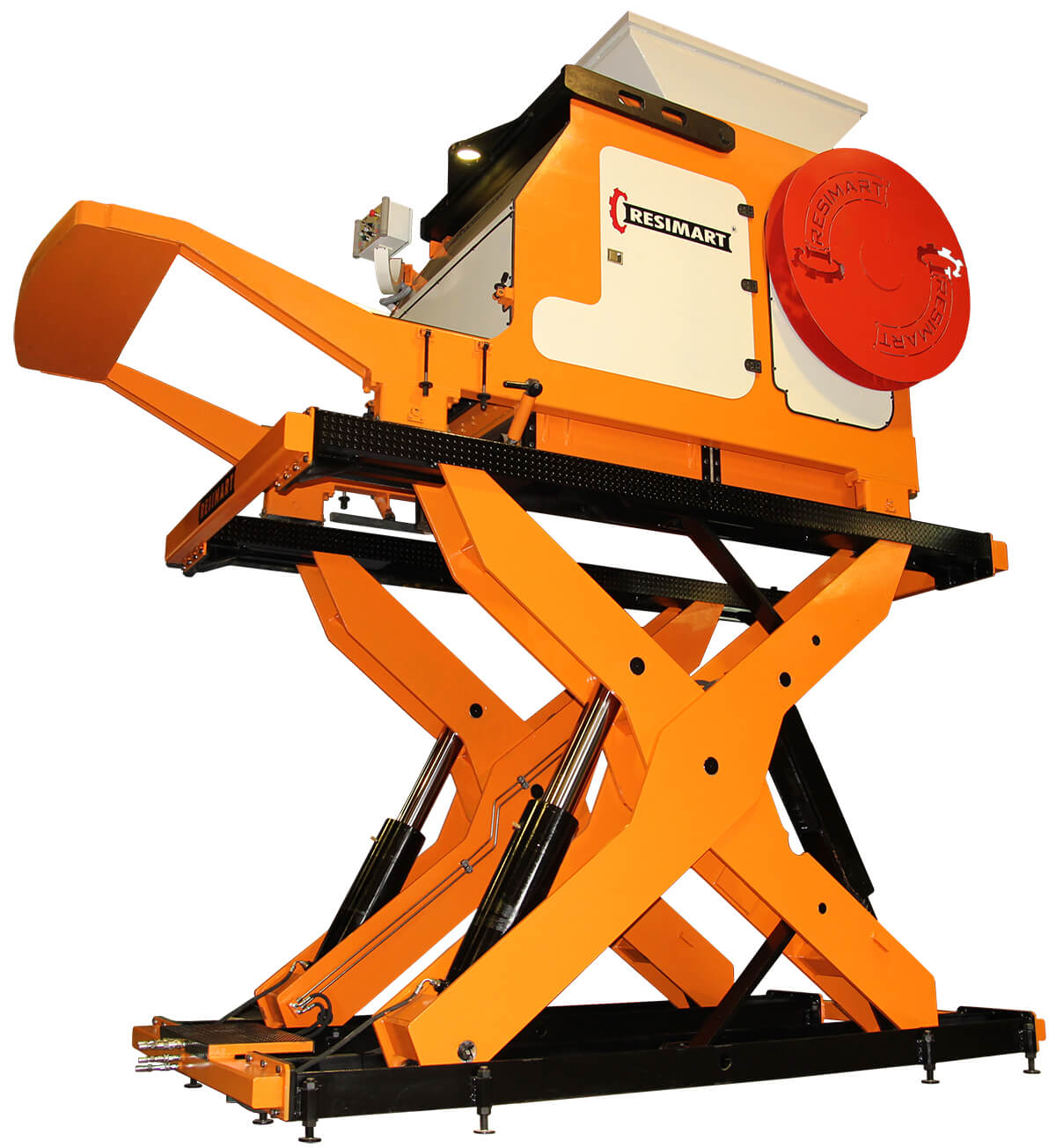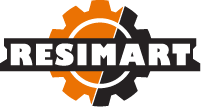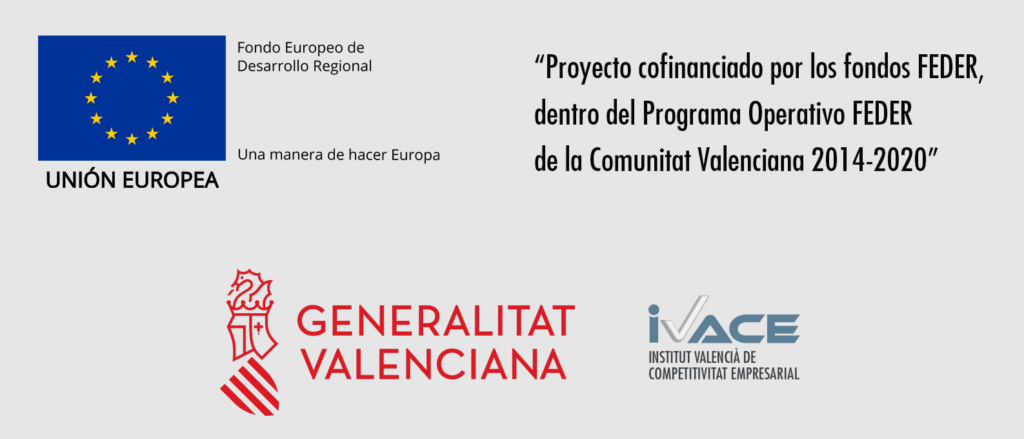Manufacturing process
- The range of products to be manufactured.
- The equipment available.
- The degree of experience gained.
- External conditions: concrete plant, storage organization, availability of handling systems, available raw materials, weather, etc.
Manufacturing process steps index
1– Preparation of the casting beds
The process starts with the obligatory cleaning of the casting beds, once the production previously molded on them has been removed. All concrete, water and mud residues must be removed, otherwise they will interfere with the next stages of work.
This process can be carried out manually, although it is best to use the bed cleaner, which guarantees better results in much shorter times.
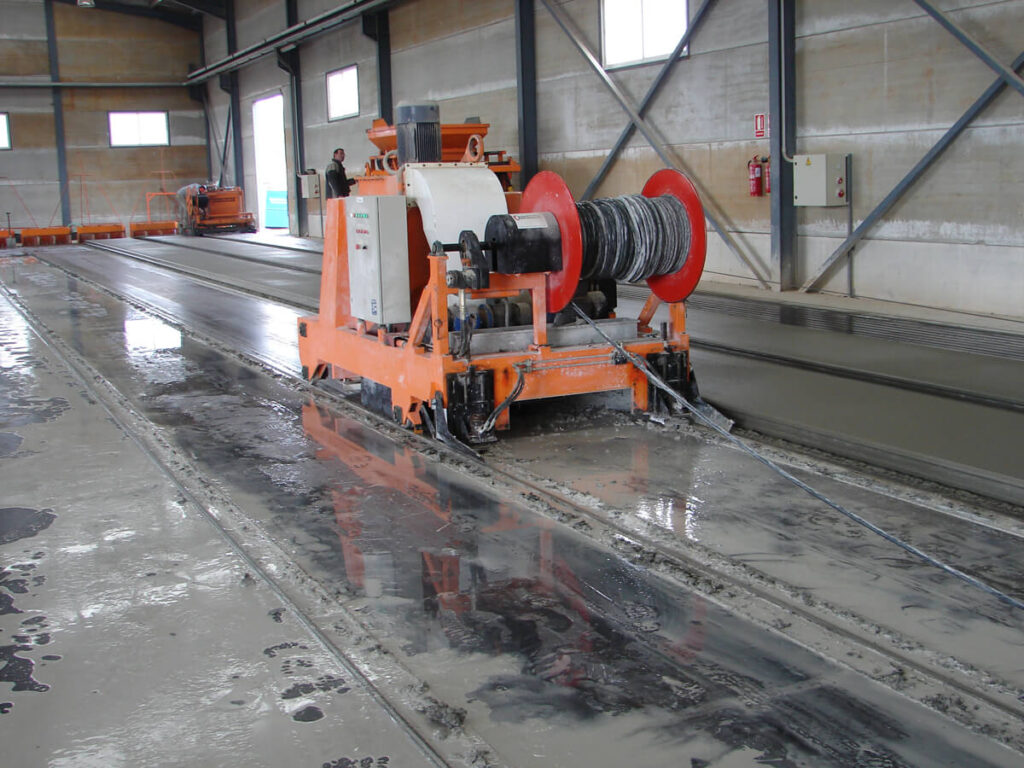
Next, it is necessary to spray the beds with a demolding agent, which will facilitate the subsequent removal of the manufactured products. This work can also be automated with the help of Resimart equipment.
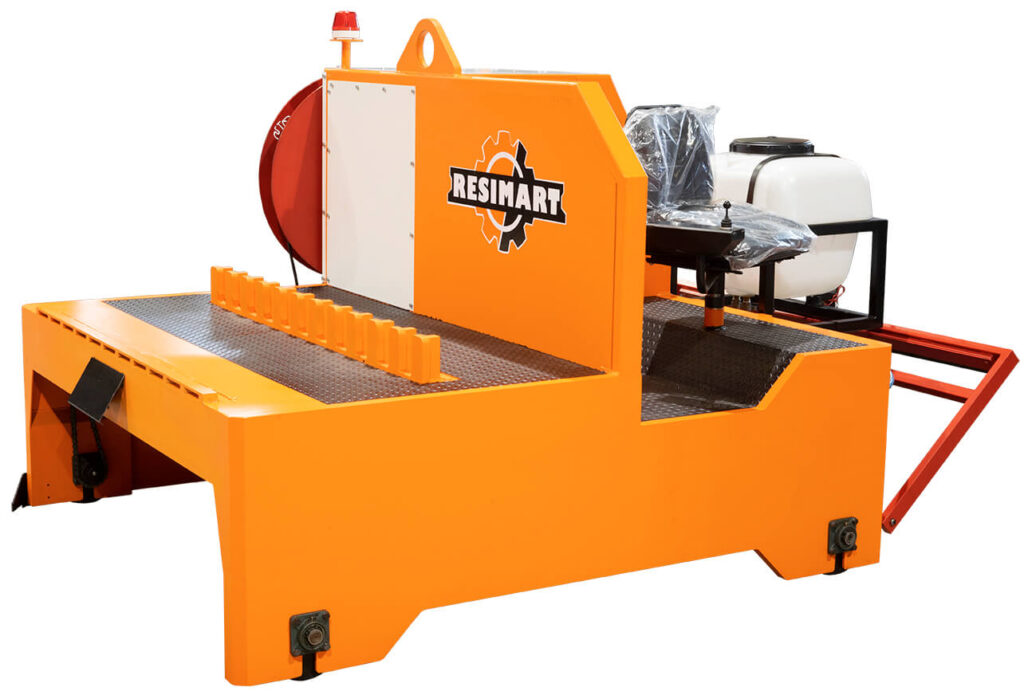
2–Wire pulling
The steel wires, responsible for prestressing the parts to be molded, must be arranged along the beds, starting from the coils housed at the beginning of them.
For this work it will be necessary to use the wire puller, which allows manipulating the wires in the different configurations specified in the technical data sheets of the products.
When positioning the cables it will be necessary to work with the different devices arranged in order to keep the cables in their exact position on the one hand and maintain the tension on the other hand.
- Wires crossing
- Hooking with the coils or other elements close to the moving wires.
3– Wire tensioning
The tensioning of the wires is the previous step to the molding of the concrete.
It is important to provide each of the arranged wires with the required tension according to their technical specifications (usually around 85% of their breaking tension), for which Resimart provides the required tensioning equipment, conveniently calibrated to minimize deviations from this critical step.
This entire process is carried out using the appropriate retention elements and without losing sight of the importance of safety at any time.
To keep the tension of the wires stable during the molding and setting process, special wedges are used, also supplied by Resimart.
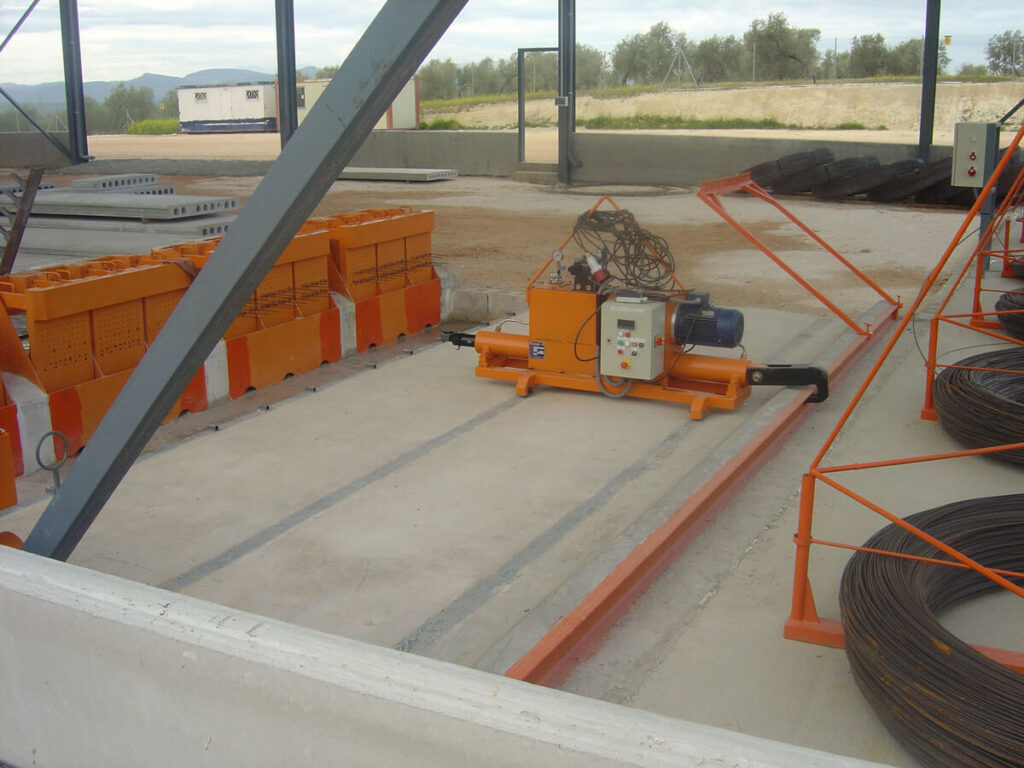
4– Concrete supply
Obviously the concrete production must be maintained during the entire molding process on the beds, ensuring uninterrupted supply to the molding equipment, whether it is vibro-compression casting machine or an extruder.
If you are looking to optimize productivity, in facilities with at least 8 casting beds, from Resimart we recommend opting for an automatic concrete distribution system which guarantees the greatest efficiency and allows freeing up resources, both human and maintenance equipment.
For more modest installations, the simplest solution is to use a container transported by one of the beam cranes, the batching plant mixer preferably being arranged in the center of the work area to optimize the routes during production.
Resimart can supply two types of container:
Manuals:
this simple model is suitable for the vibro-compression casting machine
Hydraulics:
they allow dosing the delivery of concrete, optimizing the handling process, especially recommended for feeding the extruder.
It is of crucial importance to maintain the proper pace of manufacturing and supply of the raw material, because cuts in the molding process can cause imperfections in the formed products, in addition to the well-known loss of time that productive stops entail.
Therefore, together with the availability of the appropriate container, it is recommended that the speed of the beam crane used is at least 40 m / min, although the ideal is to reach 60 m / min, to guarantee the absence of interruptions. Due to its importance, Resimart supplies beam cranes specially designed for this work.
Obviously, it is essential to have an adequate concrete batching plant. The planetary mixers are the most recommended, as they guarantee a very homogeneous mixing. A minimum capacity of 50 m3/ h will be required, in the case of small plants, increasing the figure to 100 m3/ h in the case of large plants.
Finally, the way in which the concrete is poured onto the hopper of the machines is a key aspect to guarantee good results. It is necessary to avoid the formation of cavities and ensure that the conformation is homogeneous at all times.
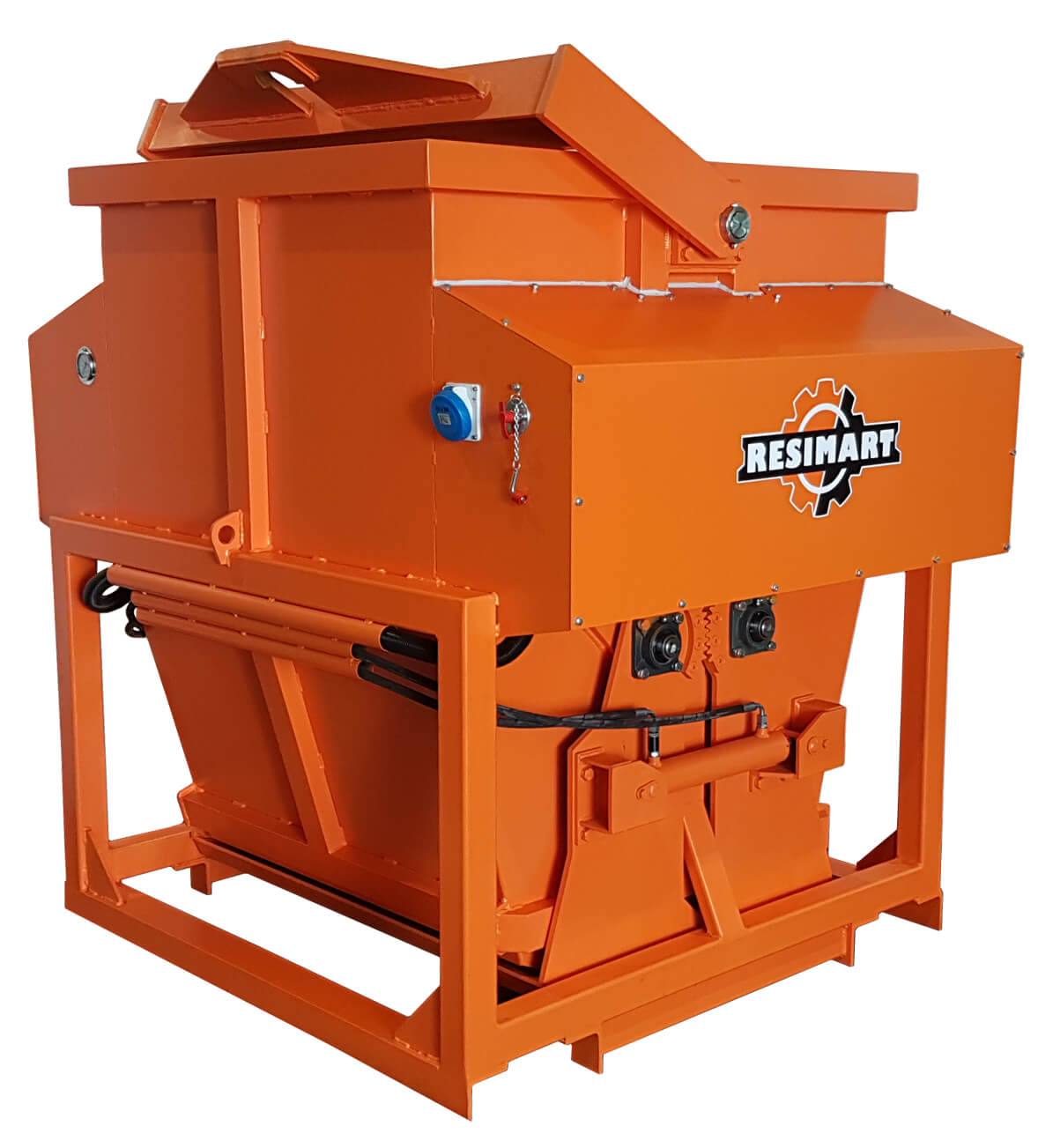
5–Molding
The molding process requires, first of all, a good concrete with the most appropriate dosage for the chosen process: vibro-compression or extrusion.
On the other hand, the handling of the equipment, and the ability to extract the best quality and efficiency from them, requires some experience, being necessary to adjust the multiple parameters in play to the intrinsic characteristics of the prefabricated plant.
Factors such as the morphology and composition of the aggregates, the cement, the available admixtures or the quality of the water play, together with the dosing and mixing of the concrete itself, a complex scenario to which it is necessary to adapt gradually and constantly.
The molding process is carried out continuously, along the entire length available for production.
When it is desired to mold discontinuously leaving “visible wires” for cutting, as required by certain construction regulations, Resimart can supply molds with a hydraulic containment system. The position and length of the sections without concrete can be programmed to facilitate the work.
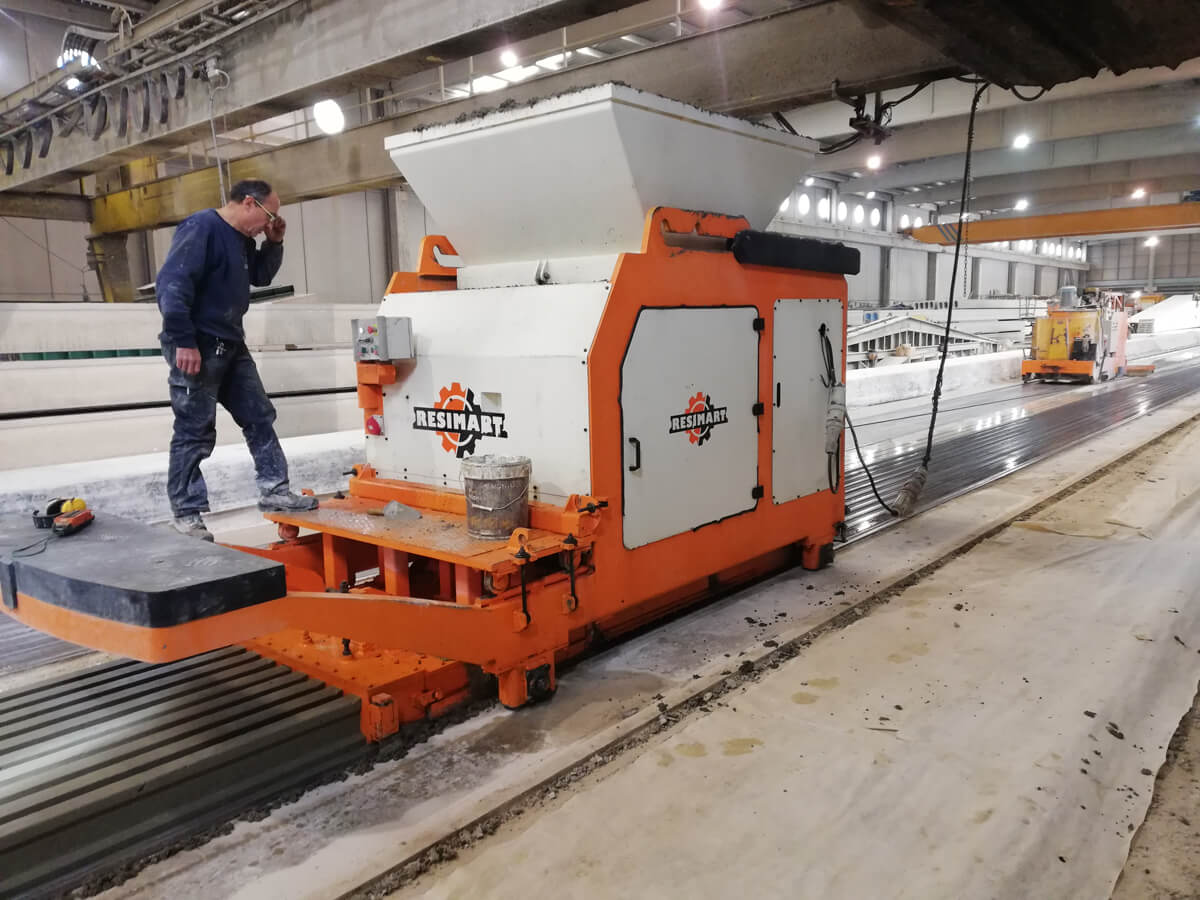
6–Finishing
In addition, in this second phase it is possible to incorporate an additional layer of mortar, specially formulated to provide the described finish.
Resimart can supply molds equipped with a simple trowel module, and that offer a functional and economical alternative to the trowel machine.
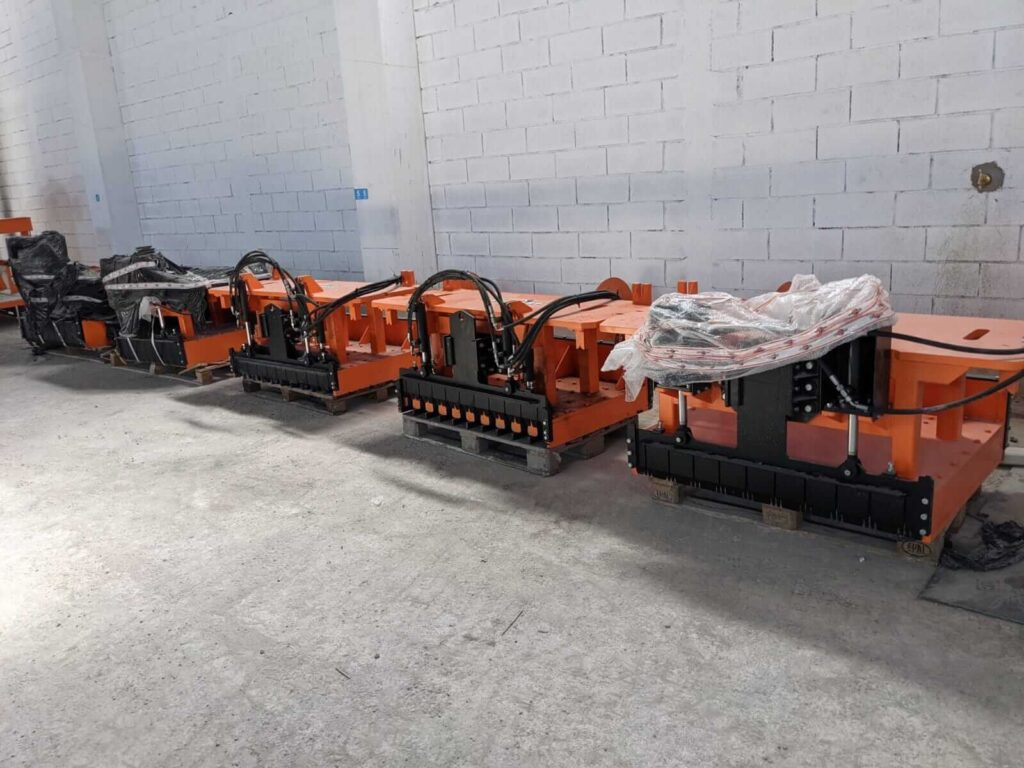
7–Setting
Once the bed has been molded, it will be necessary to allow sufficient time to elapse for the partial setting of the product to occur, to such an extent that it is possible to carry out the tensioning with guarantees that the wires will be sufficiently adhered to the pieces.
To achieve the above, usually the concrete must reach a strength of 250 Kg/cm2. Under normal conditions, this requires the passage of 24 – 48 h, a period that is significantly extended in colder climates or in larger and / or more heavily armed products.
To improve the process, the product is covered with a special plastic once molded, which allows better heat and moisture conservation during setting.
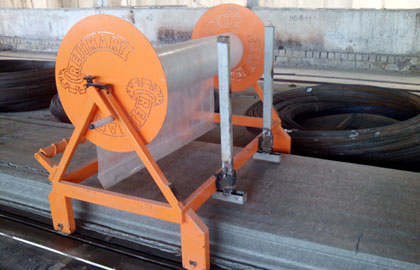
8–De-tensioning
Once the concrete has set, with the guarantees that the steel wires will be conveniently attached to the parts, they are gradually detensioned, transmitting the tension of the wires, supported by the heads to the manufactured parts.
The hydraulic de-tensioning equipment supplied by Resimart allows this stage to be developed in a progressive and controlled way, working together with the tensioning heads, thus avoiding risks and damage to the newly manufactured products.
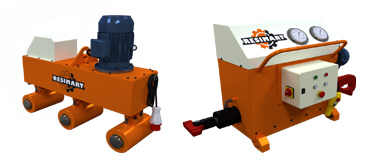
9–Cutting
The concrete molding, either by vibro-compression or by extrusion, is a “continuous” molding process so that, once the entire casting bed is formed, the products will be cut according to the desired lengths.
In Resimart we have a wide catalog of saws, depending on the requirements:
Height:
from machines with a capacity of 300mm to equipment that reaches 1000 mm, for high edge products.
Angle:
there are machines with the capacity to cut at any angle, even longitudinally, or machines for exclusively transverse cutting, more economical and simple.
Cooling:
you can opt for a water tank or the more advisable alternative of installing a water hose reeler that guarantees continuous supply.
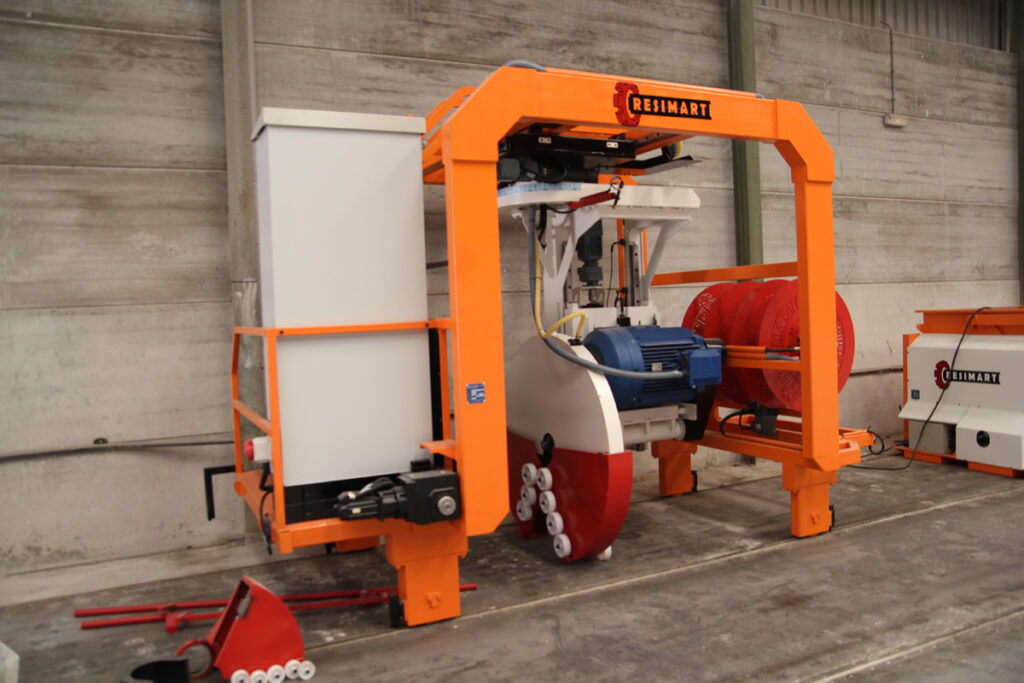
The cutting process is carried out by a special blade, which has diamond elements on its periphery, to make a cut with a good finish. Water cooling ensures the durability of the components, improves the finish of the cut and minimizes the projections of dust and other particles.
Resimart also provides a simple saw model, intended for cutting wires without concrete, ideal for those manufacturers who work with “visible wires” on which the cutting is carried out.
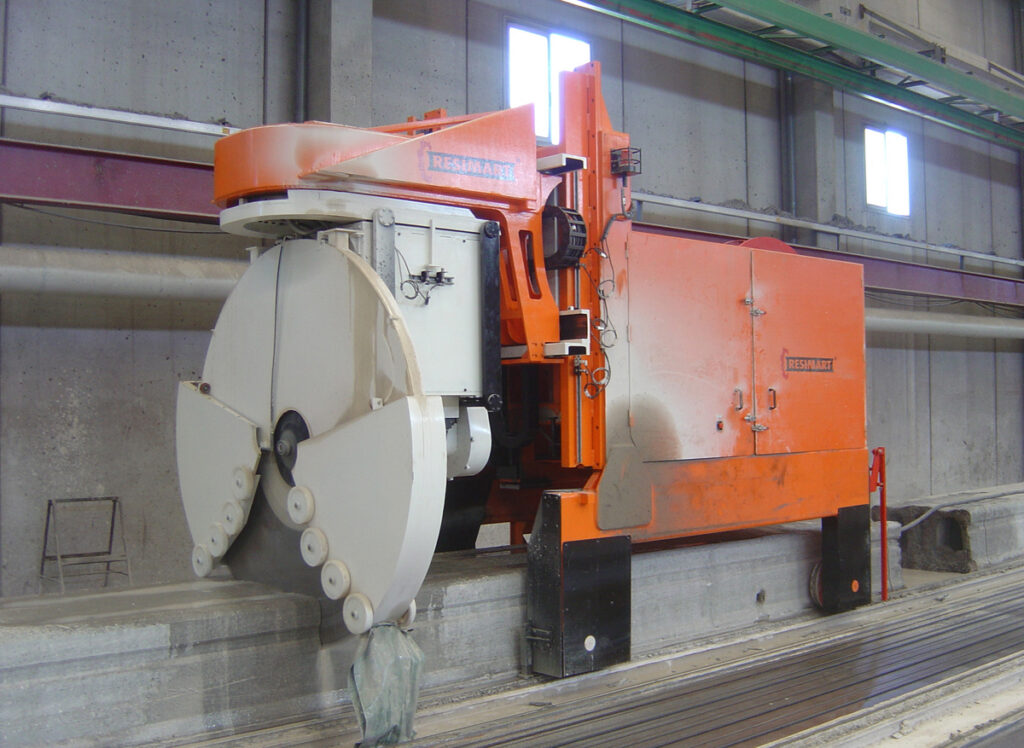
10–Plotting
The plotting process can be performed before, during, or after cutting. Basically, it is sought that the final elements have all the relevant information printed on their surface: dimensions, dates, reference, manufacturer, etc.
This is a work that has traditionally been done manually, using stencils and paint in a finish of dubious quality.
The Resimart plotter significantly speeds up this process, achieving a more efficient and quality result. This equipment also provides greater flexibility when determining the information to be included in the marking of each element, which allows complying with all local regulations related to product marking.
All of the above is feasible by programming all its functions, for which a simple and intuitive interface is available.
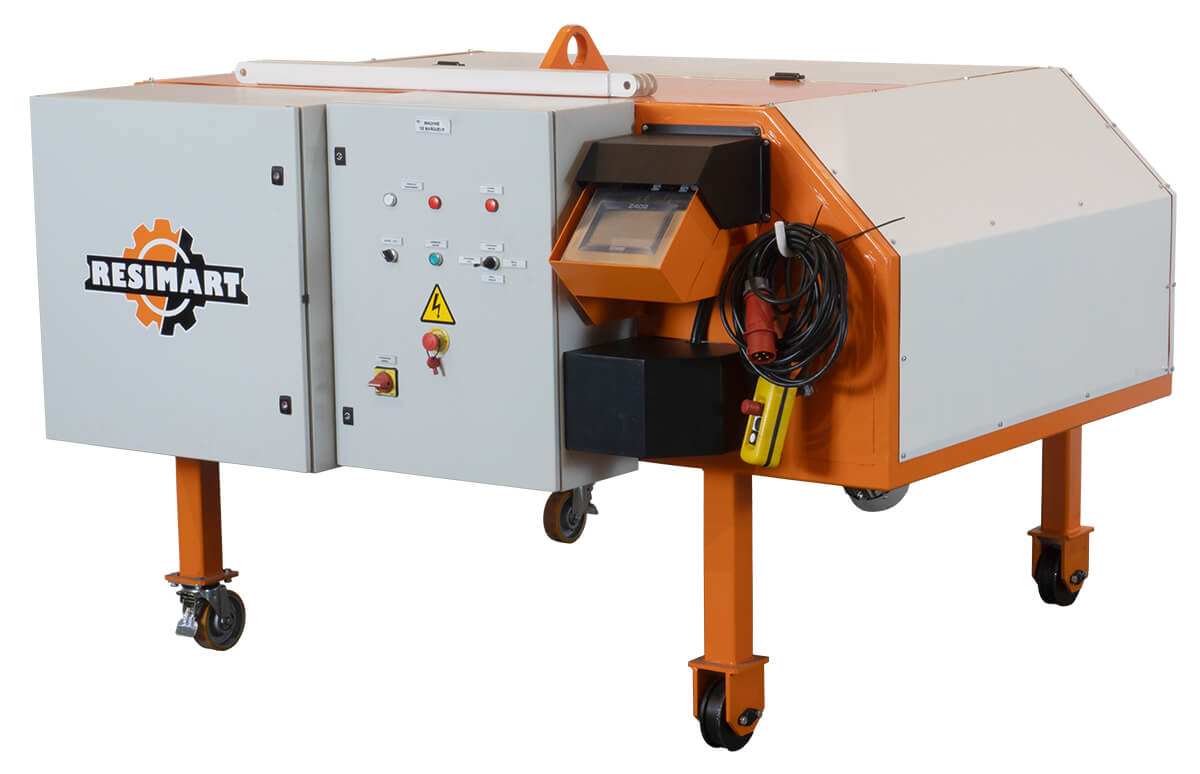
11–Extraction
Once the prefabricated elements have been properly cut and identified, the last stage will consist of their extraction from the casting beds and transport to the collection areas.
As usual, the range of options is wide, always depending on the needs and budget.
The simplest solution involves the use of manual lifting beams and clamps, designed specifically according to the geometry produced, transported by the beam cranes of the factory.
The available catalog of these equipment is very extensive, with certain variables in play. Thus, sometimes versatile devices are required, which can manipulate several geometries interchangeably. In other cases, it is sought to cover a considerable range of lengths with the same equipment, while other times it is necessary to have the safety systems required by regulations that allow their use on site. For more limited productions, very simplified clamps can be provided at a very competitive price.
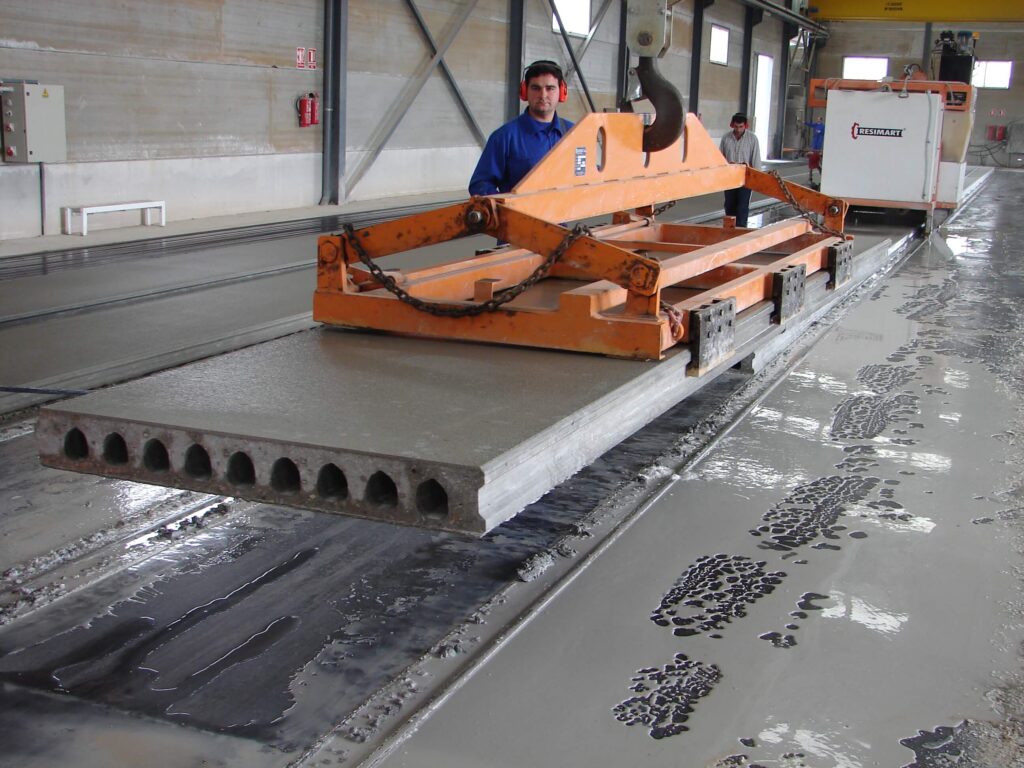
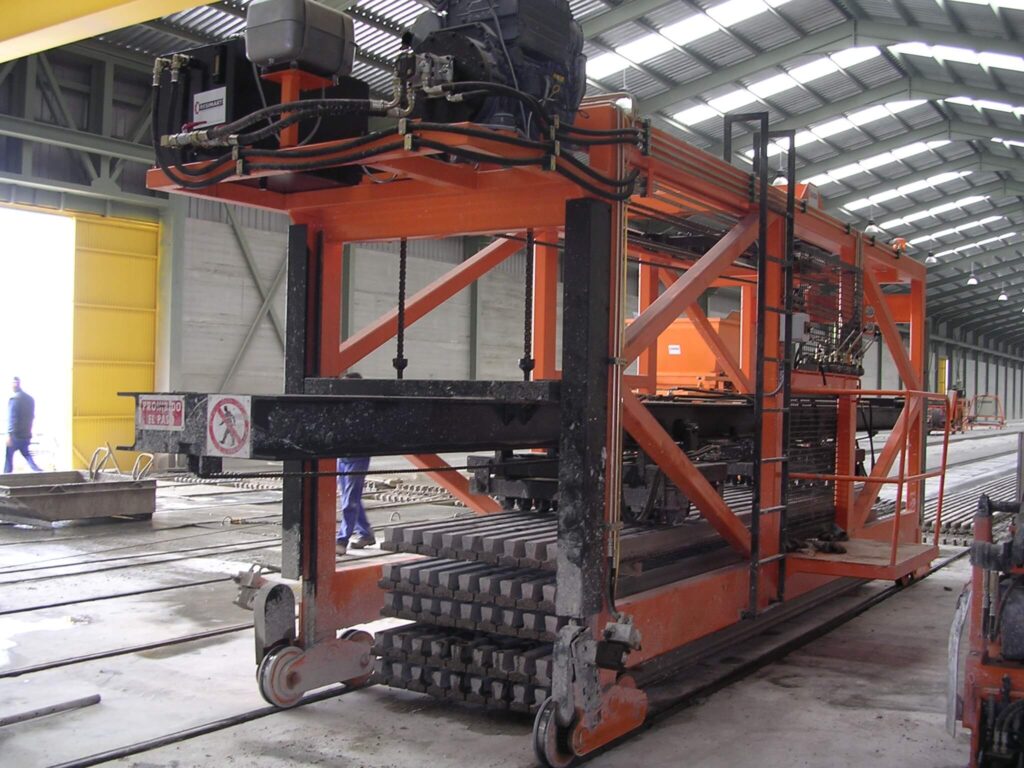
In the same way that it happens in the automated concrete handling, when we talk about high productivity installations, at Resimart we recommend having transporters. These robust equipment significantly speed up the extraction process with respect to the use of clamps and lifting beams, which also force to hog the beam crane conditioning the rest of the works of the factory.
The transporter allows to accumulate columns of product in the collection area of the workhouse, working very quickly and safely, by means of a hydraulic clamp and lifting system.
As expected, the range of equipment is varied, with simple models of 2 T, used for small joists, up to machines with a capacity of up to 20 T, designed to handle high-edge slabs.
12– Maintenance
As in any other industrial activity, the work process must be accompanied at all times by adequate cleaning and maintenance work on all those equipment involved in it.
Due to its characteristics, the precast concrete industry is especially sensitive to this point, being necessary to be very thorough in all maintenance tasks:
- Cleaning
- Grease
- Tightening of those most critical elements.
- Checking for adjustments and wear
Resimart supplies detailed maintenance instructions for each of its equipment, with the aim of prolonging its durability and minimizing failures and incidents that cause damage to production.
In addition, auxiliary equipment can be supplied, such as maintenance benches or lift tables, ideal for facilitating these jobs, to which their real importance is rarely assigned.
